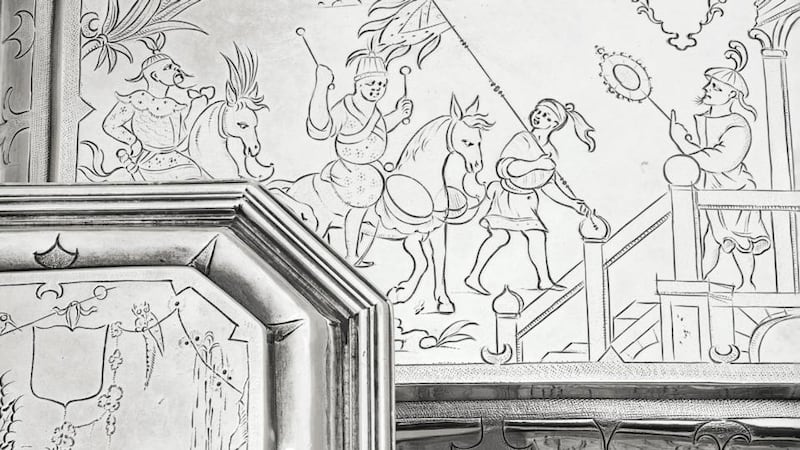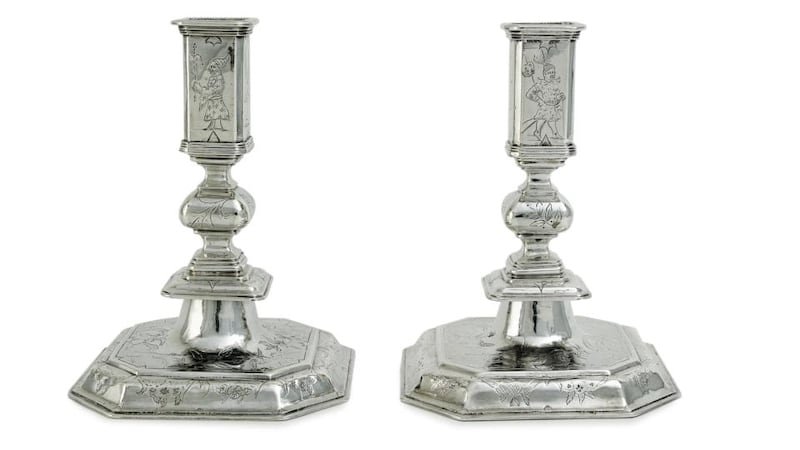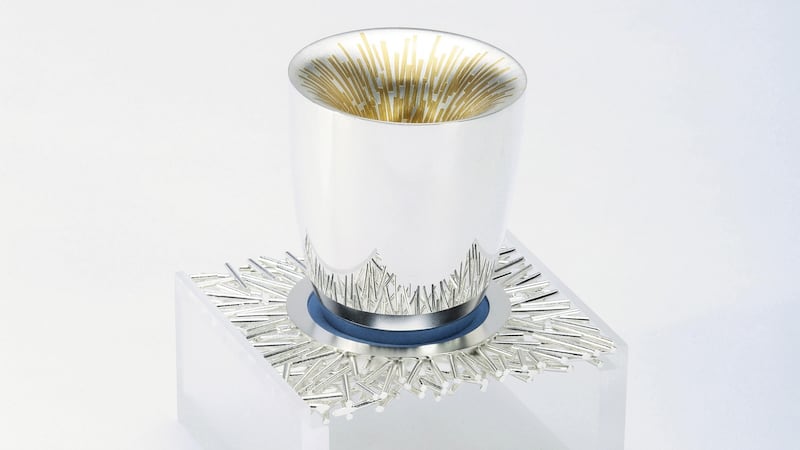Asian art is much in the news nowadays – usually when a bowl, vase or other object makes a mad amount of money at auction.
But oriental influences in the decorative arts have a long and fascinatingly complex history. In the late 17th century there was a vogue for embellishing Irish silver with Chinese-themed scenes, known as Chinoiserie; more recently, Irish makers have been using ancient techniques to create the treasures of the future.
Both aspects of our design heritage will be on display shortly at the National Museum of Ireland, Collins Barracks, where two recent acquisitions illustrate the old – and the new – at their glorious best.
The first is a very rare six-piece dressing-table set which dates from 1685. Consisting of a hairbrush, a clothes brush, a pincushion, an octagonal casket and a pair of octagonal boxes, it was purchased at Christie’s in New York on April 20th.
The pieces are decorated with a series of lively Chinoiserie scenes: a lady on a balcony greeting her suitor, a dragon drinking in a fountain, a nobleman on horseback, a riot of exotic birds and garlands of fruit and flowers. There are also buildings whose style is possibly meant to suggest a mosque, or an Eastern Orthodox Church.

Objects such as these offer an extraordinarily intimate glimpse into the mind of a 17th-century Irish silversmith – who had never been to China, and was therefore free to imagine such exotic delights as birds with ears and pomegranates the size of melons – as well as into the lives lived by wealthy 17th-century families in Ireland.
But the real triumph in this case is that the museum already owns a mirror and two candlesticks from the same set.
“We’ve looked at the decoration, the quality and weight of the pieces, the trees, the fruit, the people – they’re linked the whole way through,” says Jennifer Goff, curator at Collins Barracks, as the case containing these Stuart superstars is opened so that we can have a closer look. The dressing-table service, which has not yet arrived from New York, will be on public display by the autumn.
Chinoiserie was a bit of a passing fad in 17th-century Irish silver. It was made for just a few years, from 1680 to 1690, which is why it’s so sought after by collectors. And while most pieces from that time were so well used that the decoration has blurred and faded, these are as fresh and lively as if John Segar had just given them a final triumphant polish.
“It’s in great condition,” Goff says. “And that – ironically – is thanks to the 1798 Rebellion.”
The collection, which came from Mullingar – possibly from the Handcock family of Moydrum Castle – was placed in the vaults of the La Touche Bank in Dublin just before the rebellion. It stayed there for more than a century, and was restored to the Mullingar family when Bank of Ireland took over the bank vaults in 1870.
Real coup
The family left Ireland after Moydrum was burned down during the Civil War, and in 1930 the silver was bought in London by a Boston man, Richard Cushing Paine Sr, who passed it to his son-in-law.
This may have been when the set was divided; no one is really sure. In 1944, the well-known collector Kurt Ticher gave the mirror and candlesticks to the museum on long-term loan and they were purchased in 1962 for £1,500. Last month, the dressing-table service cost €173,000 – well above its list price of €49,000–€73,000.

“We knew there were avid collectors looking for these pieces,” Jennifer Goff says, “so it’s a real coup for us. It’s the most significant acquisition of silver that we’ve seen for a very, very long time.”
And so a piece of Ireland’s cultural past is to be reunited.
Ireland’s cultural future, meanwhile, is in the hands of the current generation of craftspeople and another of the museum’s recent silver purchases has a futuristic look. Vortex is a vessel by Eimear Conyard, who has been running the goldsmithing course for the Crafts Council in Kilkenny for the past decade.
Best-known as a jeweller and creator of elegant timepieces, Conyard has branched out into sculptural forms using the ancient Korean technique of Keum’bu.
“It’s a way of fusing pure gold on to the surface of silver,” she explains. “When I’ve made the piece, I warm it up so it goes black – that’s where the copper content is oxydising under the heat of the torch – then put it into sulphuric acid.” The process is repeated until the surface is completely white, then a piece of gold foil is laid on top.

Conyard learned about Keum-bu from a Korean silversmith when she was teaching in Canada a number of years ago. It’s meticulous, time-consuming work, but she plans to develop her skills even further in the future, possibly using porcelain and other materials as well.
Along with its companion pieces Aerie and Amphora, Vortex is currently in the process of being hallmarked at the Assay office. It will be on display alongside the silver dressing-table set in October.
National Museum of Ireland, Collins Barracks, Arran Quay. museum.ie











